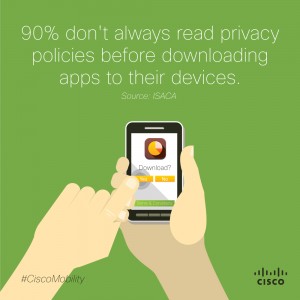This blog is part two of a three-part blog series discussing how organizations can address mobile security concerns through an architectural approach to mobility.
In my first post of this three-part series, I discussed how next-gen Wi-Fi models will pave the way for secure mobility and the value of secure Wi-Fi. In this post I’d like to take the mobility conversation a bit further and outline potential risks and rewards that IT departments face when deciding to deploy mobility solutions in our Internet of Everything (IoE) landscape.
A big factor for IT to adopt a mobility strategy with new technology and solutions is weighing the practical risks versus the rewards they stand to gain. A recent ISACA survey of IT professionals offered insight into how employed consumers think and act in terms of security and mobility. The study and ISACA’s 2013 IT Risk/Reward Barometer reveal:
- Only 4% of those surveyed named the makers of their mobile phone apps as the entity they most trust with their personal data
- 90% don’t always read privacy policies before downloading apps to their devices
Most of us are familiar with the rewards of mobility, but the belief and behavior gap illustrated by the ISACA survey proves we need to better understand risks of mobility.
Risks of Mobility
Mobility is no longer the exclusive realm of the corporate executive, it is engrained into workflow across the value chain. As a result, all stakeholders—employees, clients, partners—who want to connect to corporate networks, systems, and applications are using a variety of mobile and remote access devices to do so. The proliferation of mobile devices and the trend of users bringing in their own network-enabled devices have increased the likelihood of security threats.
According to the ISACA survey, almost all (99%) of IT professionals surveyed believe that the growth of the Internet of Things (IoT) poses some risk for enterprises, including mobility solutions. Increased security threats (38%) and data privacy are of highest concern from employees, with many believing the highest risk is other people hacking into their personal, connected devices. However, from the pool of IT professionals surveyed, many believe they should be more concerned with knowing who has access to important information.
How can organizations both address the perceptions of security by employees and the risks posed by opening networks to unmanaged devices?
IT and business leaders must implement a comprehensive, open security policy and manage remote access to the network and key applications. Most IT organizations use a combination of approaches, but with each layer of management and security there is added complexity.
Mobile applications and solutions built to handle this complexity, such as Cisco’s AnyConnect Secure Mobility Solution, allow employees to globally access the network with their device of choice, including laptops, tablets, and smartphones. They can then easily and more securely use the applications and information they need to do their jobs.
By embracing BYOD-inspired mobility, organizations can increase employee satisfaction and knowledge about security policy and procedures.
Rewards of Mobility
It’s clear that mobility is changing the way today’s enterprises conduct and manage business. Mobility is driving better productivity, heightened customer experience, and a better work/life balance. It also offers freedom for employees to work remotely and empowers them to be innovative, which can have transformational impact within an organization.
Another important benefit of mobility is how—when deployed on a secure, agile network—it can lead to more control over IT resources, especially as new wireless network solutions, device management tools, mobile apps, and cloud adoption continue to drive the future of mobility.
Organizations must have an architectural approach when embracing technologies that collect and share data so that governance remains a priority. With this path, organizations can be confident that when it comes to weighing the risks vs. rewards of implementing mobility solutions, the benefits will be worth it. Learn more about mobile security trends in the 2014 Annual Security Report.
What do you think are the biggest risks and rewards that mobility offers? Let us know via comment below or join the conversation on Twitter, #CiscoMobility.



CONNECT WITH US